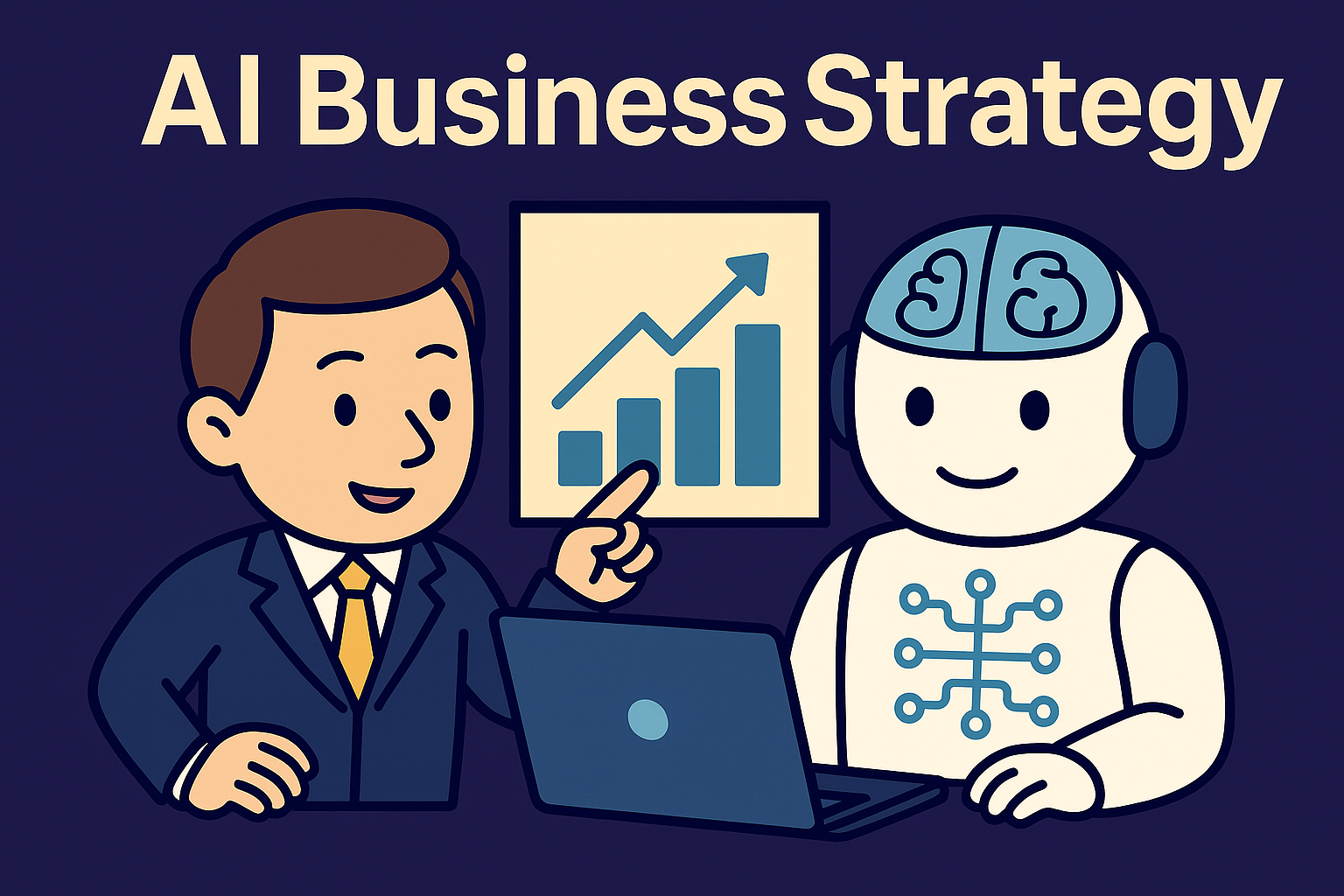In today’s rapidly evolving business landscape, integrating Artificial Intelligence (AI) into your strategic planning is no longer optional—it’s imperative. AI technologies are reshaping industries, driving innovation, and offering unprecedented opportunities for growth. This guide delves into the essentials of crafting an effective AI business strategy, ensuring your organization remains competitive and forward-thinking.
What is AI Business Strategy?
Understanding the Role of AI in Business
An AI business strategy involves the deliberate integration of AI technologies into your organization’s operations and decision-making processes. Unlike traditional strategies that rely heavily on manual processes and historical data, AI-driven strategies leverage machine learning, data analytics, and automation to enhance efficiency and innovation. Harvard Business School Online
Key Components of an AI Business Strategy
- Clear Objectives: Define what you aim to achieve with AI—be it cost reduction, improved customer experience, or new product development.
- Data Infrastructure: Ensure you have the necessary data quality and infrastructure to support AI initiatives.valuecoders.com
- Talent and Skills: Invest in training and hiring to build a team capable of developing and managing AI solutions.
- Ethical Considerations: Establish guidelines to ensure responsible and ethical use of AI.
- Continuous Evaluation: Regularly assess the performance and impact of AI initiatives to make necessary adjustments.
How AI Transforms Traditional Business Models
AI has the potential to revolutionize traditional business models by automating routine tasks, providing predictive insights, and enabling personalized customer experiences. For instance, AI can analyze vast datasets to identify market trends, allowing businesses to make proactive decisions.
How to Build an AI Business Strategy
Steps to Building an AI Strategy
- Assess Readiness: Evaluate your current capabilities, including data quality, infrastructure, and organizational culture.Just Educational Services+13valuecoders.com+13Business Insider+13
- Identify Use Cases: Determine where AI can add the most value within your operations.
- Develop a Roadmap: Outline the steps needed to implement AI solutions, including timelines and resource allocation.
- Pilot Projects: Start with small-scale projects to test AI applications and gather insights.
- Scale and Integrate: Expand successful AI initiatives across the organization, ensuring integration with existing systems.Business Insider
Identifying Business Objectives for AI
Align AI initiatives with your overarching business goals. Whether it’s enhancing customer satisfaction, increasing operational efficiency, or entering new markets, AI should serve as a tool to achieve these objectives.
Data Requirements for AI Implementation
High-quality, relevant data is the cornerstone of effective AI solutions. Ensure you have mechanisms in place for data collection, storage, and processing. Additionally, address data privacy and security concerns to maintain compliance and build trust.
What Are the Benefits of Using AI in Business?
Enhancing Operational Efficiency with AI
AI can automate repetitive tasks, streamline processes, and reduce errors, leading to significant improvements in operational efficiency. For example, AI-powered chatbots can handle customer inquiries, freeing up human agents for more complex issues.
Leveraging AI for Competitive Advantage
By harnessing AI, businesses can gain insights into customer behavior, market trends, and operational performance, enabling them to make informed decisions and stay ahead of competitors.
Improving Customer Experience through AI Solutions
AI enables personalized customer interactions by analyzing individual preferences and behaviors. This personalization can enhance customer satisfaction and loyalty, ultimately driving revenue growth.
What Challenges Can Arise During AI Adoption?
Common Barriers to AI Implementation
- Lack of Expertise: Many organizations struggle with a shortage of skilled professionals to develop and manage AI solutions.
- Data Issues: Poor data quality or insufficient data can hinder AI performance.Business Insider+2Forbes+2valuecoders.com+2
- Cultural Resistance: Employees may resist changes brought about by AI, fearing job displacement or increased complexity.
Strategies for Overcoming AI Adoption Challenges
- Invest in Training: Provide education and training programs to build internal AI expertise.
- Start Small: Implement pilot projects to demonstrate AI’s value and build organizational support.
- Communicate Benefits: Clearly articulate how AI will enhance roles and contribute to the organization’s success.
Ensuring Responsible Use of AI
Develop ethical guidelines and governance structures to oversee AI initiatives. This includes ensuring transparency, fairness, and accountability in AI decision-making processes.
How to Leverage AI Technologies Effectively
Choosing the Right AI Tools for Your Business
Select AI tools that align with your specific needs and capabilities. Consider factors such as scalability, ease of integration, and vendor support.
Integrating AI into Existing Business Processes
Ensure that AI solutions complement and enhance your current workflows. This may involve reengineering processes to fully capitalize on AI capabilities.
Building a Robust AI Team
Assemble a multidisciplinary team that includes data scientists, engineers, and domain experts. This team will be instrumental in developing, implementing, and maintaining AI solutions.
What Are the Future Trends in AI for Business Strategy?
Emerging AI Applications in Various Industries
AI is making significant inroads across industries:
- Healthcare: AI algorithms assist in diagnostics and personalized treatment plans.
- Finance: AI enhances fraud detection and risk assessment.
- Retail: AI enables personalized shopping experiences and inventory management.
The Impact of Generative AI on Business
Generative AI, which can create content, designs, and even code, is opening new avenues for innovation. Businesses can leverage these capabilities to accelerate product development and enhance creativity.
Preparing for the Next Age of AI
Stay abreast of AI advancements and continuously evaluate their potential impact on your business. Invest in research and development to explore new AI applications and maintain a competitive edge.
Embracing an AI-First Mindset
To truly harness the power of AI, organizations must adopt an AI-first mindset—prioritizing AI integration in all aspects of business strategy. Sandy Carter’s book, AI First, Human Always, provides valuable insights into balancing technological innovation with human-centric approaches. The book emphasizes the importance of ethical considerations, continuous learning, and adaptability in the AI era.
In conclusion, developing a robust AI business strategy is crucial for organizations aiming to thrive in the modern economy. By understanding AI’s role, setting clear objectives, addressing challenges, and fostering an AI-first culture, businesses can unlock new levels of efficiency, innovation, and customer satisfaction.
